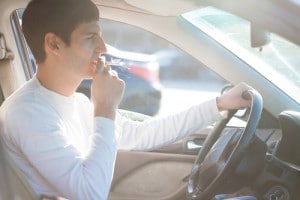Driving While Impaired on Marijuana is Difficult to Measure
 Too many people drive while intoxicated, particularly alcohol. Even a small amount of consumed alcohol can impair a driver enough that their reflexes slow down and the intoxicated driver can cause a crash. According to one survey, 79% of adults interviewed believe that alcohol-related DUIs are terrible and dangerous – however, according to the same survey, only 29% of the same respondents said that driving under the influence of marijuana was a serious problem.
Too many people drive while intoxicated, particularly alcohol. Even a small amount of consumed alcohol can impair a driver enough that their reflexes slow down and the intoxicated driver can cause a crash. According to one survey, 79% of adults interviewed believe that alcohol-related DUIs are terrible and dangerous – however, according to the same survey, only 29% of the same respondents said that driving under the influence of marijuana was a serious problem.
In 2013, one-third of fatal car accidents across the U.S. were caused by alcohol impairment. However, with the legalization of recreational marijuana in Colorado, Oregon, Alaska, and Washington state – as well as legalized medical marijuana in 19 other states – more car accidents, including fatal car crashes, have reportedly been caused by “high” drivers.
The data surrounding driving under the influence of drugs such as marijuana is tricky to interpret. The toughest part is determining how intoxicated the driver was on marijuana. Unlike alcohol, there is no marijuana “breathalyzer,” and marijuana metabolites can remain in the user’s blood stream for up to one month after consumption, well beyond any intoxicating effects of the drug.
Washington state has been particularly concerned about marijuana-caused car accidents since the state legalized recreational use in 2012. All states report their fatal car accident data to the Fatality Analysis Reporting System (FARS), which tracks numerous variables related to serious car crashes, including whether alcohol or drugs were involved. However, FARS does not have a great distinction between marijuana metabolites versus marijuana intoxication. For recreational states like Washington, a measurement of 5 nanograms of THC, the intoxicating chemical in marijuana, per milliliter of blood indicates “too high to drive.” FARS does not currently track this specific information.
After some analysis of more in-depth data, Shelly Baldwin of the Washington Traffic Safety Commission and a team of researchers concluding that the alarming statistic – that the number of fatal marijuana DUI crashes in WA State had doubled – was somewhat accurate. The number of drivers with active THC in their blood past the legal limit was more than expected. However, that number was only 6% of the drivers involved in fatal car crashes in Washington state; the remainder of “intoxicated” drivers were at or below the 5 nanogram limit, although they still had active THC in their blood.
How dangerous are drivers who use marijuana? Although driving while intoxicated is dangerous no matter what, some studies show that there are distinct safety differences between high and drunk drivers. For example, a study published in the June issue of the Drug and Alcohol Dependence journal found that drivers intoxicated on marijuana tended to weave in their own lanes, but drunk drivers would more often weave in and out of oncoming traffic lanes.
Another study, conducted by the National Highway Traffic Safety Administration (NHTSA) back in 1993, showed that people who had smoked half a joint or more tended to be more risk averse. People who drank tend to underestimate their level of intoxication, the study found, while people who had even a small amount of marijuana tended to overestimate how intoxicated they were, and take greater precautions such as driving slower and leave more space between themselves and other drivers.
A 2013 survey of medical marijuana states also suggested that while the number of marijuana DUIs increased in some places, the number of alcohol-related DUIs fell. Along with the reduction in alcohol-caused car accidents, there was a decrease in fatal car accidents.
However, mixing alcohol and marijuana has much more serious consequences, drastically increasing the risk of a serious car accident. “We know if you combine alcohol with THC, you really mess with your risk of crashing,” Baldwin says. “At the .08 level, you’re about seven times more likely to get in a crash.”
